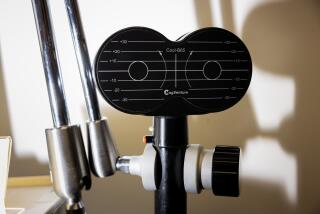Is vasopressin what’s lacking in the brains of those with autism?

Researchers have found that male rhesus monkeys who tend to shun group play, mutual grooming and other social activities have a subtle thing in common with boys who have an autism spectrum disorder. In both cases, they have unusually low levels of a hormone called vasopressin.
Outside the brain, vasopressin helps regulate blood pressure and fluid retention. But in the brain, it has long been thought to play a role in social, sexual and nurturing behavior. And because it interacts with male hormones such as testosterone, some scientists suspect it could be implicated in autism, which affects boys at about four times the rate that it does girls.
So researchers from Stanford University, UC San Francisco and UC Davis decided to explore whether vasopressin levels might be a biological marker for autism. In both humans and rhesus monkeys, they found, levels of the hormone in cerebrospinal fluid — generally a clue to its concentration in the brain — were markedly higher in individuals without social deficits than they were in the least social members of both groups.
Their findings, reported this week in the journal Science Translational Medicine, could reveal some key secrets about a disorder that afflicts more than 3.5 million Americans. The most recent report from the Centers for Disease Control and Prevention found autism spectrum disorder in 1 in 59 American children studied.
Identifying a “biomarker” for autism would be a valuable discovery.
Autism is thought to spring from a variety of genetic and environmental factors, and its defining features — including communications difficulties, impaired social skills, repetitive behaviors and aggression — vary widely in their severity. The disorder is typically diagnosed on the basis of a behavioral checklist, and often too late (on average, just short of a child’s 4th birthday) for behavioral interventions to have their full effect.
A physiologic test for autism might make earlier diagnosis easier. It might help distinguish some forms of the disease from others, or predict its likely severity. And if that biomarker were also a factor in causing it, researchers might glean some new ways to treat the disease.
“These are preliminary data that are compelling and interesting, but we still have a lot of follow-up to do,” said study leader Karen J. Parker, who directs Stanford’s Social Neurosciences Research Program. But she said the team already has launched a clinical trial to explore the safety and effectiveness of intranasal vasopressin as treatment for children with autism.
The investigators began their work with a group of rhesus monkeys, which are known for their sociability. The 30 animals ranged in age from 1 to 5 years old, and they had already been extensively observed by researchers at the California National Primate Research Center at UC Davis.
On the basis of those observations, researchers sedated the 15 most social and 15 least social monkeys in the group. Then they drew samples of cerebrospinal fluid and compared the hormone levels of monkeys in each group.
Using statistical models and a form of machine learning to classify each monkey’s autism status, the cerebrospinal measures of vasopressin emerged as “a key marker of group differences,” the authors wrote. They confirmed that finding in an additional group of 30 male monkeys.
To get some preliminary confirmation of their findings in humans, they drew on an existing trove of cerebrospinal fluid collected from boys at medical centers across Northern California. In this analysis, seven boys with autism spectrum disorder were compared to seven boys without it. (All of the study’s subjects had undergone the uncomfortable procedure for health reasons unrelated to their social functioning.)
Sure enough, the boys’ vasopressin levels were “sufficient to distinguish [autism spectrum disorder] cases from controls,” the authors wrote.
The fit wasn’t perfect: Two of the seven who had received an autism diagnosis had vasopressin readings that fell within the range of kids with no such diagnosis. But among all seven boys with no ASD diagnosis, vasopressin levels were much higher — sometimes by a factor of two or three — than for the remaining five.
Parker, a professor of psychiatry and behavioral sciences at Stanford, said the study’s findings for now are limited to boys. That’s not only because all of the subjects were male but because vasopressin interacts with sex hormones and may play a different role in boys than in girls.
In girls and women, the hormone oxytocin is powerful in promoting nurturing behavior and trust. Researchers have established in many studies that it, too, may act differently in people with social impairments. It is actively under investigation as a treatment for autism.
But for men and women, oxytocin levels rise and fall throughout the day, largely in response to such social cues as a baby’s cry or the sight of one’s dog. But the new study found that vasopressin levels, by contrast, remain stable over long periods. That’s another clue that it may be implicated in autism.
MORE IN SCIENCE
Can you skip your regular workout and just shiver instead?
The shape, not size, of our ancestors’ brains may have helped them outlast Neanderthals
Brainstorming the ethics of neuroscience research in the age of organoids







